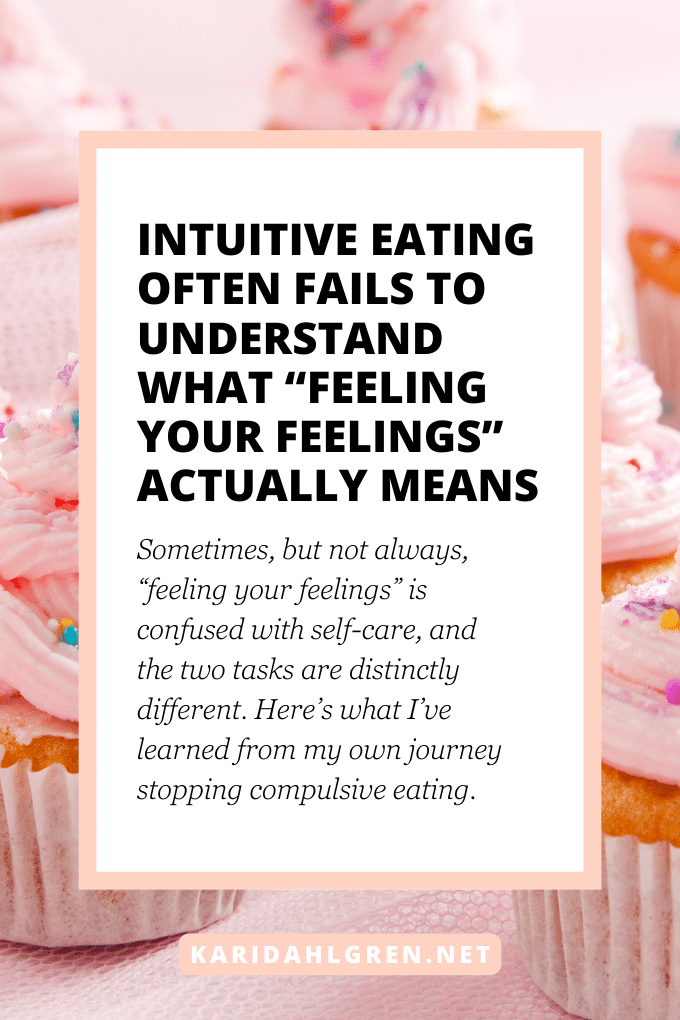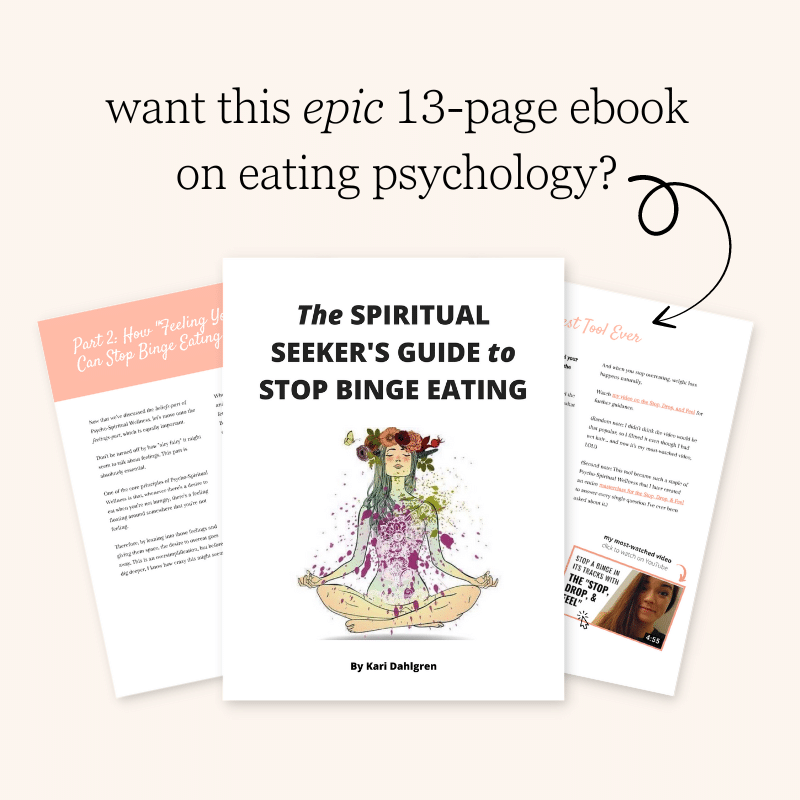
“Feeling your feelings” was a relatively new concept for me seven years ago when I first gave up dieting. Maybe it’s new for you too, or maybe you’re well aware of it. Either way, I want to cover this topic in a new light, because I believe the intuitive eating sphere often gets it wrong, causing many people to feel like a failure or abandon intuitive eating altogether.
Recently, I was reading the book Health at Every Size. I strongly believe in the ideology: that you really can be healthy at any size; that we should focus on intuitive eating and intuitive movement over weight loss; and that we need to get past unfair weight stigmas. I believe in everything that HAES as a movement stands for.
Once I started reading HAES the book, however, I was grossly appalled—pissed, actually—by the poor advice on how to “feel your feelings.” I find the author does not understand how to help people stop compulsive eating outside of the step of giving up dieting, which is just one step of many.
I intentionally separate myself from the classical intuitive eating sphere for this reason (among many). While my philosophy, Psycho-Spiritual Wellness, has much in common with intuitive eating, I think classical intuitive eating fails to touch the depths of what “feeling your feelings” actually looks like—and it truly is a spiritual practice.
Today, I’d like to discuss what goes into “feeling your feelings,” specifically in the arena of stopping compulsive eating. It’s much more than self-care, and it’s extremely difficult. However, once you develop skill here, it will unlock enormous potential.
What Exactly Does It Mean to “Feel Your Feelings”?
I’ll never forget the day that I listened to a podcast from Brooke Castillo where she talked about why it’s okay to feel bad; and why we should actually embrace this and “get good” at it. At the time, I had never really heard anyone say anything like this.
Immediately, I noticed that when I stopped resisting bad feelings, I felt less bad. And that felt like a win! Then, on a random day, I decided to “feel my feelings” when I had a craving for candy after lunch. I thought, “I wonder if there’s something here.” It was a casual, flippant thought. Then, I dropped in… and burst into tears. I was sad and I didn’t even know it.
I actually documented this pivotal moment in the following YouTube video from 2018. To be honest, this video makes me cringe because I was still very new to making videos, but it is a true documentation of my journey of stopping compulsive eating.

The craziest part is that I was sad but I had no idea. This is what really opened my eyes to the emotions behind compulsive eating. They’re big; they’re strong; and we often have no idea that they’re there, so it takes a lot of convincing to give the Stop, Drop, & Feel a try.
Fast forward a bit and I spent a good deal of the next year starfished on my bed and feeling really awful. Whenever I thought to myself, “Why can’t I stop eating when I’m full?“ I’d heed my own advice and go to my bedroom, set a timer for 2 minutes, and surrender to my feelings.
Loneliness and a fear of rejection were the most common emotions I felt. It was really hard to sit with those emotions, even for just two minutes. And I think this is what’s missing from the conversation about “feeling your feelings” in the intuitive eating sphere.
Some intuitive eating coaches might as well shrug while they say it. “Yeah, feel those feelings!”
But me… I like to take a deep breath in, slow my roll, and say, “Yeah, feeling your feelings in the precise moment that you want to overeat is going to knock you off your feet—and it might even knock you straight on your ass—but you can do it. Just try it for two minutes—which will feel like the longest two minutes of your life—and that alone is enough for one day. And in time, you will develop tolerance for your discomfort, I promise. You will also discover more about yourself than you ever thought possible while doing this extremely difficult task.”
Yeah, there’s a lot more to “feeling your feelings” than “just doing it.”
Feeling Your Feelings Should Be Regarded Separately from Self-Care
In the intuitive eating sphere, it seems that “feeling your feelings” is confused with self-care, and the two tasks are distinctly different. Let’s dive into a section from the book Health at Every Size that confuses these two topics in a manner that truly made my blood boil.
(Note: I always reference the HAES the book, not the social movement, because Health at Every Size as a movement is something strongly support.)
On page 211, the author gives advice specifically on the topic of feeling your feelings. She says,
“If you’ve identified the emotion(s) in your mind, try to experience them rather than drown them in food the next time they hit. Some things I recommend include writing in a journal; talking with friends; releasing your emotions physically, such as punching a pillow, running, crying, or screaming; talking to a psychotherapist.”
Linda Bacon
Let’s break this down, while even ignoring the crass nature of this advice. Aside from item #3—releasing your emotions physically—these tasks help with self-care, but they don’t exclusively involve feeling your feelings, and exclusivity is important. In fact, item #2—talking with friends—is just another buffer.
And replacing one buffer with another does not address compulsive eating.
Please don’t misunderstand me: I thoroughly support all of these self-care tasks, especially talking to a psychotherapist. That said, for the sake of stopping compulsive eating, self-care should be accompanied by other tasks that involve zero buffers—like the Stop, Drop, & Feel.
I fully advocate item #3, particularly the crying. (The screaming is good too, but screaming is a form of anger, and anger is often a secondary emotion.) Crying is an example of truly letting emotion in, and it illustrates what I said earlier about “feeling your feelings”—that it might even knock you straight on your ass—and as unattractive as this sounds, it’s actually a skill you want to practice. Seriously! It’s how you develop the ability to sit still with your edginess; it’s how you become the eye of the storm; and it’s how you stop compulsive eating long-term.
To me, this is a spiritual practice.
Where Eating Psychology Meets Spiritual Practice
Now I’d like to dive into the spiritual side of Psycho-Spiritual Wellness by introducing you to Pema Chodron, an American Tibetan Buddhist nun, spiritual thought leader, and bestselling author.
Pema reminds us that the daunting task of sitting still with discomfort is a spiritual practice—a practice that takes enormous strength. Her book When Things Fall Apart is one of my favorites because she does an excellent job of encouraging us to sit with our edginess and explaining what that looks like: extremely difficult.
“Most of us do not take these [uncomfortable] situations as teachings. We automatically hate them. We run like crazy. We use all kinds of ways to escape—all addictions stem from this moment when we meet our edge and we just can't stand it. We feel we have to soften it, pad it with something, and we become addicted to whatever it is that seems to ease the pain.”
Pema Chodron
“Generally speaking, we regard discomfort in any form as bad news. But for practitioners or spiritual warriors—people who have a certain hunger to know what is true—feelings like disappointment, embarrassment, irritation, resentment, anger, jealousy, and fear, instead of being bad news, are actually very clear moments that teach us where it is that we're holding back. They teach us to perk up and lean in when we feel we'd rather collapse and back away. They're like messengers that show us, with terrifying clarity, exactly where we're stuck.”
Pema Chodron
She even eloquently said,
“Rather than letting our negativity get the better of us, we could acknowledge that right now we feel like a piece of shit and not be squeamish about taking a good look.”
Pema Chodron, Nun
Writing in a journal and talking to a psychotherapist are excellent forms of emotional self-care. You should make time for them. But they are distinctly different from feeling your feelings because they actually help buffer your emotions, even if just slightly. While journaling or talking, you’re still somewhat separated from the distinct edginess of sharp emotions.
To me, “feeling your feelings” in the precise moment that you want to eat without hunger looks like wanting to bolt by reaching for a bag of chips but staying with yourself in that moment, despite how excessively edgy it is, and surrendering with curiosity. As the second tick by, you keep wondering how on earth it hasn’t been two minutes yet, because all you want to do is crawl out of your skin.
That’s “feeling your feelings” instead of buffering with food. It’s the hardest practice I ever took up in my entire life, and also the most rewarding. And it’s distinctly different from self-care.
Self-Care vs. “Feeling Your Feelings”
Self-care is, by definition, “the practice of taking an active role in protecting one’s own well-being and happiness, in particular during periods of stress.” Even the definition of self-care is removed from feeling bad!
Feeling your feelings involves surrendering to your emotion without any extra layers or buffers. You aren’t venting to a friend; you aren’t supported by a therapist. It’s just you and your emotions, going at it one-on-one. Again, I am not saying we don’t need our friends and therapists!! We need them dearly. But they are ways of taking care of yourself emotionally, not necessarily “feeling your feelings” all the way through.
For the sake of stopping compulsive eating, try to couple “feeling your feelings” with emotional self-care. Do the Stop, Drop, & Feel first by setting your timer for two minutes and surrendering to your edgiest emotions. Then, do something that will make you feel better like calling up a friend or scheduling a therapy session. These are non-food coping mechanisms, and they’re perfectly fine and encouraged—so long as they are not a replacement for the act of “feeling your feelings.”
Rant, Over
I was very surprised that Health at Every Size, the book, has a different focus than HAES the movement. Everything about the movement I agree with! Much of what’s in the book makes me mad.
Care to let me know what your opinion is? Leave me a comment below! I read and reply to them all.




I completely agree with you! HAES does have many worthwhile points BUT it’s not perfect and that’s why I abandoned the book when I read it a couple of years ago. I was happy with the overall picture, but some points made me feel worse about myself. I think your method of feeling your feelings is the missing puzzle piece. Feeling bad emotions is something I’ve been subconsciously scared of and thanks to you I’ve recognized this and I’m trying not to use food as my softening tool. Thank you so much for this article. It’s one of many that are helping me along my journey.
I am so glad this was helpful Megan! It makes me feel less crazy too, knowing that HAES the book also didn’t sit well with you either. “Feeling your feelings” is very brave work, and I applaud you for rolling up your sleeves with it. 🙂